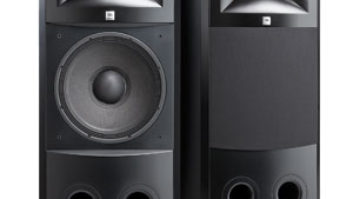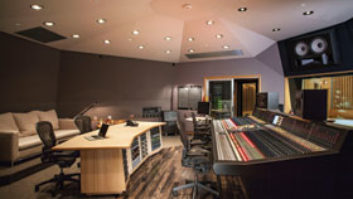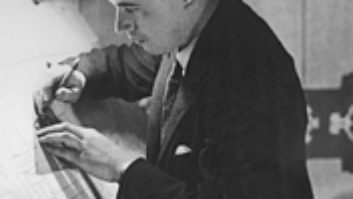
This fun ’60s ad showed a baker making fresh
MD-421s. More than 500,000 have been sold.
Today, the Sennheiser name is associated with high-quality pro and consumer audio products, but the company stems from modest beginnings. In 1945, post-war Germany was in shambles, and Dr. Fritz Sennheiser and seven other employees of the Institute for Radio Frequency Engineering and Electroacoustics at Hannover Technical University were left with virtually nothing. German scientists were then prohibited from doing research in radio technology, so Sennheiser used his savings to create a business making millivoltmeters for Siemens.
“Then we had a stroke of luck,” the 93-year-old Sennheiser recalls. “Siemens asked if we could make microphones for them.” After building mics for Siemens, the team began designing its own mic and in 1947 debuted the MD 2, a dynamic mic that found favor with radio stations. The company grew and expanded into other products, such as amps, intercoms, transformers, headphone capsules and the 1953 MD 21 mic, which is still in production. Based on a lab model developed in 1949, the company’s 1956 MD 82 was the first shotgun mic. A move into wireless mic production followed a year later.
By 1958, the company had 450 employees and made the wise decision to change its name from the original “Labor W” (Laboratorium Wennebostel) to Sennheiser Electronic. During the 1950s, the company’s sales grew tenfold, but Sennheiser always returned to the community, splitting his time between running the company and teaching at Hannover Technical University — a tradition continued by his son (and current chairman of the company’s supervisory board), Prof. Dr. Jörg Sennheiser.
Dr. Fritz Sennheiser, today
The innovations continued, with the 1960 MD-421 dynamic studio mic (which sold more than 500,000 units and is still a studio favorite today) and in 1964, the first RF condenser shotgun mic. In 1968 came the HD 414 (the first open-air headphones), a definite hit that in 10 years provided more than half of the company’s sales, establishing Sennheiser as a leader in the consumer market. In the ’70s, the company merged its headphones with infrared technology, creating interference-free wireless headsets for home, tour guide and assistive listening systems. The ’80s brought a major expansion into ultra-reliable UHF wireless mic systems that made Sennheiser a first choice on London and Broadway stages.
In 1982, managing the company was transferred from father to son, but this did not change Sennheiser Electronic’s role as a technology leader. The company has received numerous accolades in this regard, including a 1987 award from the Academy of Motion Picture Arts & Sciences for the industry-standard MKH 816 shotgun mic and a 1996 Emmy for developments in RF wireless. However, doing things differently has also played a vital role in the company’s success. In 1984, Sennheiser was the first medium-sized company in Europe to use modern surface-mount technology. Today, while other companies turn to low-cost third-world manufacturing, Sennheiser has plants in Germany, Ireland and Stateside in Albuquerque, N.M.
“To protect against currency fluctuations,” says ,Jörg Sennheiser of the U.S. plan, “we pursued a strategy that might be described as ‘natural hedging.’ We compensate for fluctuations by attempting to have the same expenditure in dollars as we have income in dollars.”
In 1991, Sennheiser purchased a financially troubled Neumann, a change that provided the best of both worlds: Neumann could access modern electronics manufacturing, while the “old-world” processes — such as capsule hand-assembly — would be done under clean room conditions. Other companies might have been tempted to buy Neumann and then cash in via cheap products with a famous name — a familiar scenario — but Sennheiser is committed to maintaining Neumann’s reputation for excellence.
The Sennheiser/Neumann relationship continues. The two collaborated on the KK105S wireless mic that combines Neumann’s famed KMS105 capsule with Sennheiser’s SKM 5000 UHF wireless rig. More recently, loudspeaker manufacturer Klein + Hummel joined the Sennheiser Group.
Sennheiser is successful, but business integrity remains a priority. Jörg Sennheiser once refused a lucrative deal to produce some 200,000 weatherproof mic capsules when he realized they were to be used as land mine triggers. But this has always been the company way, a policy dating back to the early days of Labor W, when Fritz Sennheiser invested his savings to create jobs for his co-workers. Marketing and sales president Rolf Meyer is sure that this attitude will continue. “With his philosophy of always giving his engineers space to carry out research and make discoveries, Prof. Dr. Fritz Sennheiser made a decisive mark on the company. Therefore, we look forward to even more pioneering developments from Sennheiser.”







